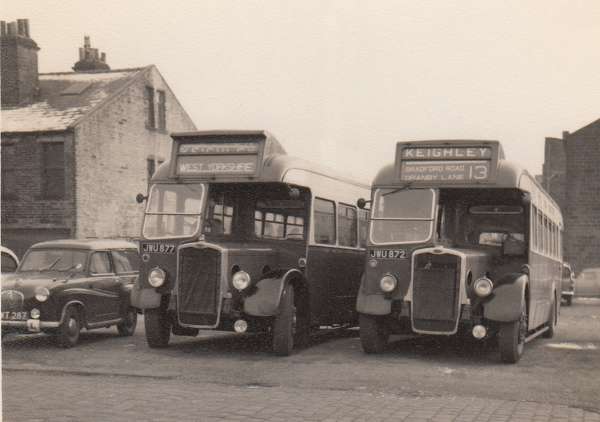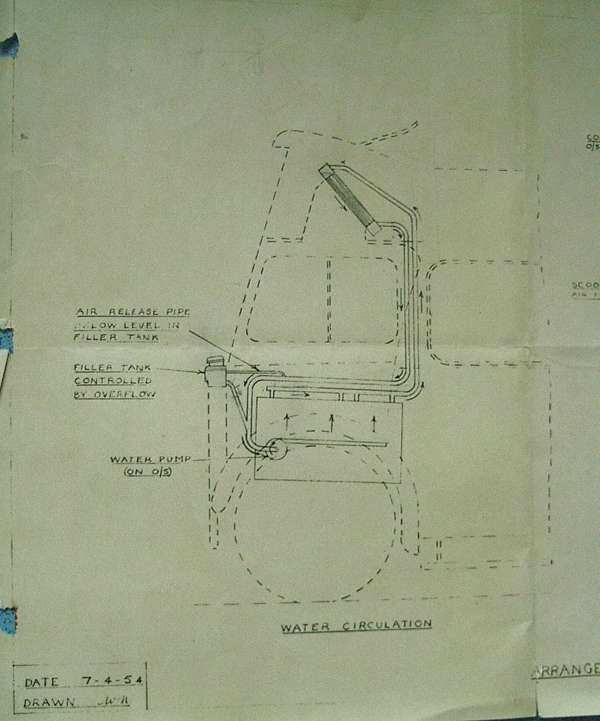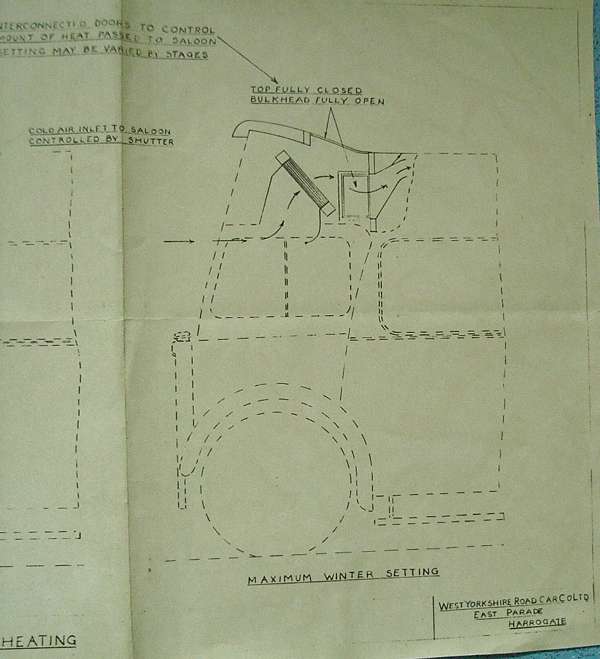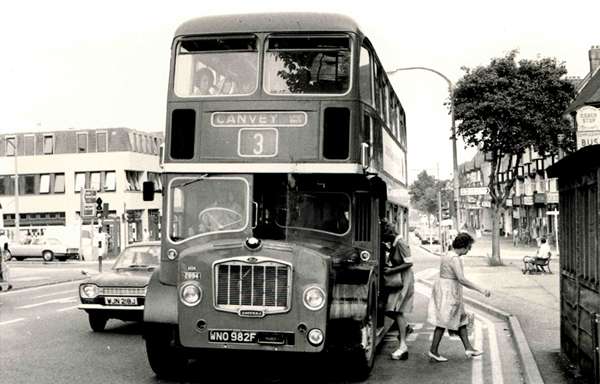Bristol Lodekka and the Cave Brown Cave System
Bristol Lodekka and the Cave Brown Cave System
Being brought up in the Manchester area, the Lodekka was something I only encountered on trips with my Dad, on holiday and later, when travelling on business.
Something that never occurred to me before is that whilst many of the type used the Cave Brown Cave system of cooling/heat exchanging, others didn't - sometimes fleets had similar vehicles with and without depending on the batch.
Could someone outline the pros and cons and why some operators had both specs or point me in the direction of an explanation, preferably on the net.
Phil Blinkhorn
16/05/13 - 06:36
Wing Commander Cave-Brown-Cave was I think later Professor of Engineering at the University of Southampton, which was where he came up with the idea that a heat-exchanger system would be more efficient at cooling the engine whilst warming the saloons than a conventional radiator . . . it wasn't, see www.flickr.com/photos/ for the evidence! I think the reason the system failed was that buses stop and start, and there just wasn't the flow-through of air to keep the system working efficiently, and if the engine was worked hard on - on hilly routes - that just added to the problems (Bristol OC struggled with their CBC Lodekkas). Why did Tilling/Bristol CV adopt the system to the extent that they did? - I'm sure somebody out there has an idea . . .
Philip Rushworth
16/05/13 - 11:22
I had often wondered how it acquired this name. I thought it was three people! I once queried here without success the two ducts at the back end of a VR- not heating/cooling but giant vac holes for sucking fag & mints packets out- or does anyone know different or what became of them in use? They don't seem to have caught on...
Joe
16/05/13 - 13:53
Cave Brown Cave was Professor of Engineering at Southampton following a very interesting career in the RAF and some rather clever wartime work as head of the Directorate of Camouflage.
In some ways the CBC heating/cooling system, as applied to buses, had a hint of the Heath Robinson about it but Bristols were obviously convinced of its benefits.
It would also be interesting to know how the modified system used on Manchester's last PD2s differed from the system used on the Lodekka, apart from the obvious visible differences.
Phil Blinkhorn
16/05/13 - 16:36
I don’t think it’s widely known that West Yorkshire Road Car fitted CBC systems to three single deckers in the 50s, and to my knowledge these vehicles ran with the modifications until disposal. Originally they tried fitting it to a pre-war L5G, but then fitted it to an LS5G and two LL5Gs. Here is the LS and one of the LLs. On the photograph of the LLs you can see the difference in the modification of the indicator box. The three drawings are ex-West Yorkshire official ones and I think they clearly show how the system works.
David Rhodes





17/05/13 - 07:04
Thanks for a very useful answer David. I certainly wasn't aware of the use on single deckers, and the drawings make the way the system works very plain.
Phil Blinkhorn
17/05/13 - 07:05
An account of the origins and development of the Cave-Browne-Cave heating and ventilation system can be found in the TPC book 'Southampton City Transport' by A K MacFarlane-Watt, published in 1977.
The account is too long to reproduce here but the origin of the system is interesting in that it came from an approach from the Ministry of Transport to the Society of Motor Manufacturers about 'unhygienic and unpleasant conditions' found on buses. The matter was passed to the Motor Industry Research Association and actioned by Wing Commander Cave-Browne-Cave, the Association's Technical Director and also a Professor of Engineering at Southampton University. Southampton City Transport became involved as one its Guy Arabs, number 162, was the test bed for the system.
Michael Elliott
17/05/13 - 18:12
Interesting comment from David in respect of the vehicles WYRCC used for their trials. I have a bought slide of what I'd always thought of as an MW in this format. I can't read the registration, but the fleet number is SMG 1. My knowledge of the operator is limited to what I used to see in Morecambe on the X88.
Pete Davies
25/05/13 - 08:22
David, thank you for posting the drawings of the CBC system as applied to West Yorkshire's L types, as I'd often wondered exactly how the system worked on the single-deckers. As you say, WY converted three L types and an LS, and the Company was heavily involved in much of the early CBC experimental work. The first two vehicles to be modified in 1953 were LL5Gs 413 (JWU 883) and 407 (JWU 877) respectively, both dating from 1951. (These vehicles were later renumbered SGL13 and SGL7). In 1954, a recently withdrawn 1940 L5G (182: DWW 587) had its bible-type destination display replaced by a radiator, air intake and ventilator assembly - the front intake being of a louvered type similar to that on the LS5G in David's photo. The L5G was not operated in service, unlike the LL5Gs, but was used solely as a test bed vehicle. Following on from these experiments, dual-purpose LS5G EUG1(LWR 431) was converted in late 1954. As can be seen from the shot, the CBC equipment was mounted within the front dome, with the destination box being moved to a position below the windscreen as a result. This vehicle was later demoted to bus status and renumbered SUG1, and later still, fitted with bus seats, equipped for one man operation, and renumbered SMG1. It retained the CBC system until withdrawal, and could be seen regularly in Harrogate with its distinctive small 'shark's fin' air outlet mounted on the roof towards the front of the vehicle.
As a WY apprentice, the first fitter I worked with was a thoroughly likeable chap (and AUEW shop steward) called Albert Jackson. Albert had worked on the two LL5G conversions, and been involved in fitting them up with the CBC system. I remember him saying that you needed to be something of a contortionist when fitting the radiators and pipework above the cab and within the confines of the destination box. (At that time Albert would have been about thirty years of age, so presumably may have been chosen for his agility!). He said the experience was etched in his memory, but on the positive side he did say he had found the experiments very interesting to take part in. He may well have seen the technical drawings you have posted David!
Brendan Smith
23/12/14 - 06:00
Most interesting comments about this. May I add some thoughts?
A clear advantage of the system, from an air circulation point of view, was that conventional floor-mounted heaters just heated up stuffy air that was already inside the bus.
The CBC system allowed natural air pressure, as air struck the front of the bus, to push fresh air into the bus. Therefore (as on a Routemaster, which has a small grille on the front), the natural constant ingress of fresh air over a radiator/heat exchanger keeps the bus relatively condensation free, and fresh. It worked.
Possibly the biggest failing of the system was that it was not pressurised. So, if the engine became hot and water overheated, water would be lost when the bus was at low revs, by vertically 'fountaining' out of the air vent pipe which was on the top of the small header tank, and thereby all over the bonnet top (or, in extreme occasions, in a jet right up the front of the bus).
Had the system had a pressurised overflow, this would have lessened the opportunity for water to be easily expelled and for the remainder to boil, resulting in a jet of steam from the said vent.
Top Deck Travel retained its CBC system for buses that ran overland trips. I was intrigued as to how they managed to keep them cool - and I found that they had significantly increased the size of the header tanks.
Naturally, with the majority of the radiator water in two tanks above upper saloon floor level, and the header tank at engine-top level, just gravity would tend to assist water to be expelled, as did any air locks in the system.
As was mentioned above, gentle revving at a constant speed when topping up the radiator, would draw water in and expel air out.
The other flaw was the lack of any kind of fan(s) for the twin radiator tanks. So if the system was heading towards boiling, there was nothing to stop that other than natural air flow. Instructions in the cabs of CBC Lodekka FLFs told drivers to ensure the rad vents diverted hot air outside the bus if the temperature gauge read above 200F (i.e. to give maximum airflow across the tanks).
Gardner engines tend to get hot and expel water on constant climbs. So, with the unfanned and unpressurised system, a long hill climb, with a following wind especially, would ensure minimal airflow, if any, into the CBC vents. Then, the first time the bus would stop for any length of time, with low revs on tick over (and reduced water pumping action), water would be expelled in a fountain from the vent from the header tank, which could be dangerous for any conductor, whose face would be about 2ft from that pipe when clambering up the front to change the destination/number blinds.
On most FLFs, the CBC tanks were also covered by thermostatically controlled Varivane shutters, as has been mentioned. These could also stick shut (as their 'default' position) and so, in many fleets, small rubber bungs would be inserted in some buses where this became problematic. Obviously, as all airflow was blocked with the Varivanes shut (very efficient, to warm up the radiator from cold) if the engine reached normal temperature, but the vents stayed shut, boiling would quickly result.
Gardner engines could take a lot of cooking, so it wasn't unduly common for buses to boil for significant periods without seizing. Bristol BVW engines seemed worse than Gardners for boiling issues with CBC cooling systems.
But most of the time, most buses ran perfectly well, with good flows of heat and keeping fresh, in cold weather. Ironically, when the system boiled, the airflow would often become cold, either through lack of water, or drivers correctly diverting airflow to outside, rather than inside (which was done by 'umbrella handle' handles to the offside of the windscreen on older CBC FLFs, and air-operated switches on later examples).
Following some nasty incidents with people becoming scalded, and some operators (Bristol itself being one) having issues, the CBC system was tending to be shunned more and more - although some operators, like Southern Vectis (which had none) and Eastern Counties (which had just a handful of FS5Gs so equipped, I think the only 5-cylinder Gardner Lodekkas to have CBC) - the system was eventually dropped.
The basics of the system made sense and worked well. It only failed through mainly the unpressurised and unfanned system and the small header tank.
I hope this will add to peoples' understanding.
Bristol-ECW double-deckers' visible overheating displays returned with the Series 3 VRT/SLs of course, where (unlike the VRT/SL and VRT/SL2 variants) the radiator was given a vent pipe on the side of the roof just behind the front offside corner. This was meant to have been long enough to contain radiator water even if at boiling point, but in practice, would not, leading to cascades of rusty brown water from the roof down to the driver's cab windows. But of course that was just a radiator overflow, not part of a heating and ventilating system as the CBC vents were.

The attached photo shows a 'rare capture' by me of a FLF6LX Lodekka, where the system had reached boiling point and a fountain of boiling water is being ejected from the small header tank, through the small hole between bonnet top and front cowling, and is splashing the underside of the canopy. It was known for some buses to eject a fountain of water over the roof or into the upper deck front window hopper-vents at times. In my experience, each bus was different. Some operators (Crosville being one) actually fitted some CBC Lodekkas 'straws' to the vent pipes, so that water would be blown back over the bonnet top rather than loosely up the front of the bus. The last time I saw this was on an ex-Eastern Counties CBC FS5G.
John G. Lidstone
25/12/14 - 07:11
It has always puzzled me that West Yorkshire, who experimented with CBC which they fitted into two post-war L types (LL5G and one LS type) seemed not to have problems with these. I remember one LL5G, SGL7, was a regular on my local route and I was never aware of it boiling up, even though the route was quite hilly. I rode on the LS conversion (SUG1) and even had a trip on it on service 53 Bradford to Harrogate and it seemed fine. I have to say though that this latter vehicle did look very strange with its destination box full of cooling vents and the desti fixed below the windscreen. They led normal service lives in this form. Does anybody else know otherwise?
David Rhodes
Comments regarding the above are more than welcome please get in touch via the 'Contact Page' or by email at obp-admin@nwframpton.com
All rights to the design and layout of this website are reserved
Old Bus Photos from Saturday 25th April 2009 to Wednesday 3rd January 2024